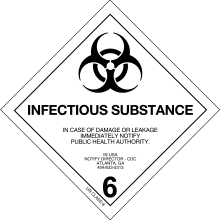Infectious substances
Infectious substances are substances that are known or can be assumed to contain pathogens . The pathogens mentioned here are microorganisms such as bacteria , viruses and rickettsiae , but also parasites, contagious fungi and prions that can cause diseases in humans and / or animals and infect them.
Arrangements for the handling and transport of dangerous goods are in the inland navigation and the European Agreement concerning the International Carriage of Dangerous Goods by Road ( ADR set). In most countries - including Germany - they are to be marked so that appropriate precautionary measures can be taken if necessary.
Classification and examples
The class of infectious substances is divided into four different groups, the UN number is given in brackets:
- Code I1 (UN 2814): Infectious substances, dangerous for humans
- Code I2 (UN 2900): Infectious substances, only dangerous for animals
- Code I3 (UN 3291): Clinical waste, provided it cannot be assigned to the infectious substances of category A (UN 2814 and UN 2900)
- Code I4 (UN 3373): Biological substance - Category B
The classification of infectious substances in class 6.2 ADR (2.2.62.1.4 ff.) Is based on three levels:
- Category A: An infectious substance that is transported in such a form that it can cause permanent disability or life-threatening or fatal disease in otherwise healthy people or animals.
- Category B: An infectious substance that does not meet the criteria for inclusion in Category A.
- Excepted medical or veterinary sample: Samples taken from humans and animals that have a minimal likelihood of containing pathogens are not subject to the provisions of ADR if the sample is transported in packaging that prevents any release and is appropriately labeled .
Examples of code I1 (UN 2814) are cultures of Brucella , Clostridium botulinum or cultures contaminated with the Ebola virus .
Examples of Code I2 (UN 2900) are infectious substances that contain the foot-and-mouth disease virus , the rinderpest virus or the sheep and goat pox virus.
Examples of code I4 (UN 3373) are diagnostic samples that are taken, for example, in medical practices or clinics (blood, urine, saliva, etc.).
Examples of "exempt medical samples" are screening tests or samples from cytodiagnostics .
See also
literature
- Hans-Günter Triebel, Wolfgang Spohr, Benedikt von Hebenstreit: Initial training for the driver of dangerous goods. Verlag Heinrich Vogel, 2003, ISBN 978-3574232053 , p. 53.
- Monika Krautwurst: ADR 2015 with collection of dangerous goods regulations by road: European agreement on the international carriage of dangerous goods by road . Verkehrsverlag Fischer, Düsseldorf 2015, ISBN 978-3-87841-666-1
Individual evidence
- ^ [1] , Transport of medical samples in road traffic , CMK Logistik Breisach.
